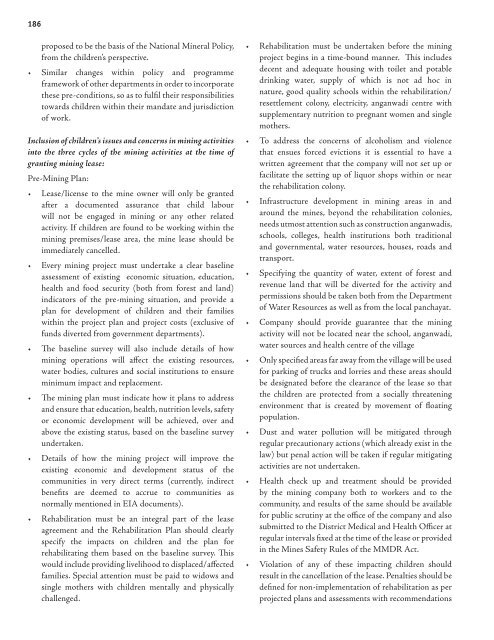Children - Terre des Hommes
Children - Terre des Hommes
Children - Terre des Hommes
Create successful ePaper yourself
Turn your PDF publications into a flip-book with our unique Google optimized e-Paper software.
186<br />
<br />
proposed to be the basis of the National Mineral Policy,<br />
from the children’s perspective.<br />
<br />
framework of other departments in order to incorporate<br />
these pre-conditions, so as to fulfil their responsibilities<br />
towards children within their mandate and jurisdiction<br />
of work.<br />
Inclusion of children’s issues and concerns in mining activities<br />
into the three cycles of the mining activities at the time of<br />
granting mining lease:<br />
Pre-Mining Plan:<br />
<br />
<br />
<br />
<br />
<br />
<br />
<br />
after a documented assurance that child labour<br />
will not be engaged in mining or any other related<br />
activity. If children are found to be working within the<br />
mining premises/lease area, the mine lease should be<br />
immediately cancelled.<br />
<br />
assessment of existing economic situation, education,<br />
health and food security (both from forest and land)<br />
indicators of the pre-mining situation, and provide a<br />
plan for development of children and their families<br />
within the project plan and project costs (exclusive of<br />
funds diverted from government departments).<br />
<br />
mining operations will affect the existing resources,<br />
water bodies, cultures and social institutions to ensure<br />
minimum impact and replacement.<br />
<br />
and ensure that education, health, nutrition levels, safety<br />
or economic development will be achieved, over and<br />
above the existing status, based on the baseline survey<br />
undertaken.<br />
<br />
existing economic and development status of the<br />
communities in very direct terms (currently, indirect<br />
benefits are deemed to accrue to communities as<br />
normally mentioned in EIA documents).<br />
<br />
agreement and the Rehabilitation Plan should clearly<br />
specify the impacts on children and the plan for<br />
rehabilitating them based on the baseline survey. This<br />
would include providing livelihood to displaced/affected<br />
families. Special attention must be paid to widows and<br />
single mothers with children mentally and physically<br />
challenged.<br />
<br />
<br />
<br />
<br />
<br />
<br />
<br />
<br />
<br />
<br />
project begins in a time-bound manner. This inclu<strong>des</strong><br />
decent and adequate housing with toilet and potable<br />
drinking water, supply of which is not ad hoc in<br />
nature, good quality schools within the rehabilitation/<br />
resettlement colony, electricity, anganwadi centre with<br />
supplementary nutrition to pregnant women and single<br />
mothers.<br />
<br />
that ensues forced evictions it is essential to have a<br />
written agreement that the company will not set up or<br />
facilitate the setting up of liquor shops within or near<br />
the rehabilitation colony.<br />
<br />
around the mines, beyond the rehabilitation colonies,<br />
needs utmost attention such as construction anganwadis,<br />
schools, colleges, health institutions both traditional<br />
and governmental, water resources, houses, roads and<br />
transport.<br />
<br />
revenue land that will be diverted for the activity and<br />
permissions should be taken both from the Department<br />
of Water Resources as well as from the local panchayat.<br />
<br />
activity will not be located near the school, anganwadi,<br />
water sources and health centre of the village<br />
<br />
for parking of trucks and lorries and these areas should<br />
be <strong>des</strong>ignated before the clearance of the lease so that<br />
the children are protected from a socially threatening<br />
environment that is created by movement of floating<br />
population.<br />
<br />
regular precautionary actions (which already exist in the<br />
law) but penal action will be taken if regular mitigating<br />
activities are not undertaken.<br />
<br />
by the mining company both to workers and to the<br />
community, and results of the same should be available<br />
for public scrutiny at the office of the company and also<br />
submitted to the District Medical and Health Officer at<br />
regular intervals fixed at the time of the lease or provided<br />
in the Mines Safety Rules of the MMDR Act.<br />
<br />
result in the cancellation of the lease. Penalties should be<br />
defined for non-implementation of rehabilitation as per<br />
projected plans and assessments with recommendations






